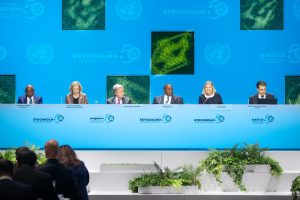- SIWI – Leading expert in water governance
- /
- Latest
- /
- Turn the tide on plastics – from source to sea
Turn the tide on plastics – from source to sea

Pollution and marine litter are high on the agenda when the UN Environmental Assembly (UNEA) convenes on 28 February. Could this mark a turning point in the fight against marine plastics? Maybe, but only if the world starts focusing on the wave of pollution from rivers and land. Applying the source-to-sea approach could be a big part of the solution.
Ahead of the UN Environmental Assembly, 28 February to 4 March, there has been a steady flow of reports warning that pollution, chemicals, and waste are spiraling out of control. Without bold action, ocean plastic pollution could quadruple by 2050, according to the Worldwide Fund for Nature.
The more than 100 member states participating in the UNEA meeting will therefore draw up a blueprint for the first-ever global treaty on plastic pollution. The UN Environment Programme, UNEP, believes that such an agreement is crucial to turning the tide on marine litter – if it is ambitious enough:
“The proposals being deliberated by Member States envision actions, from source to sea, that address all sources of pollution along the whole lifecycle – from production through disposal and reduction of the leakage of existing plastics to be recycled safely and to foster a circular plastics economy,” says Inger Andersen, Executive Director of UNEP.
It is important that the head of UNEP emphasizes that action must be taken from source to sea, since this is the only way that the agreement could have an impact. Ahead of UNEA, some stakeholders argue for a much more limited treaty, for example focused only on plastic already released into the ocean. But SIWI argues that this would not be effective.
Here are five reasons why the treaty must cover all sources of plastic pollution and encourage a source-to-sea approach across the plastic life cycle:
1. Most of the pollution stems from land-based sources far away from their impacts where people may not even be aware of the problems they are causing. Plastic pollution from cities is doing serious harm not only to waterbodies nearby but also to rivers, coasts, and the ocean in other regions and countries.
2. The Source-to-Sea Framework for Marine Litter Prevention, developed by SIWI with funding from the German development agency GIZ, addresses the connection between land, river, lakes and aquifers, coasts and the ocean. The Framework highlights the need to bring together upstream and downstream communities and to coordinate management across sectors – using a source-to-sea approach.
3. The Framework calls for a better understanding of the impact of plastic pollution as it travels through river basins and out to sea. By understanding the impacts of plastic pollution across the entire source-to-sea system, the argument for investing in a circular economy is strengthened.
4. Recognizing the benefits for the source-to-sea system as a whole, can create new incentives for drastically improved solid waste and wastewater management and more circular production patterns, two of the most important transformations according to the OECD’s first Global Plastics Outlook.
5. Similarly, the holistic source-to-sea approach makes it easier to protect fragile coastal environments that mitigate the impacts of climate change. Mangroves, seagrasses, salt marshes and coral reefs store significant amounts of carbon and serve as natural barriers against rising seas and storms. But the majority of them are close to polluted rivers and therefore under growing pressure from land-based plastic pollution.
A recent UNEP report sheds new light on how plastic pollution is harming Earth’s natural systems, aggravating problems such as the biodiversity breakdown and climate instability. But the dangerous trend can be reversed through bold international action that adopts the source-to-sea approach as a fundamental principle.
Interested in learning more about the Source-to-Sea approach? See related materials below
Join the Action Platform for Source-to-Sea Management
Does your organization want to be part of the movement?
Know more









